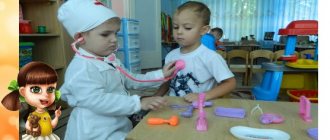MAGAZINE Preschooler.RF
Summary of the manual for a role-playing game on the topic: “Hospital” for children 3-4 years oldCompiled and conducted by teacher Burmistrova M.S. Volodarsky village 2019 DEPARTMENT OF EDUCATION OF THE ADMINISTRATION OF LENINSKY MUNICIPAL DISTRICT MUNICIPAL AUTONOMOUS PRESCHOOL EDUCATIONAL INSTITUTION "KINDERGARTEN No. 14 "YAGODKA"
Goal: to expand children’s understanding of the work of hospital workers; to develop in children the ability to apply previously acquired knowledge about life around them in play.
Tasks:
- Teach children to interact in stories with two characters (doctor, patient)
- Teach children to show interest in the playful activities of their peers
- Lead children to understand their role in the game
- Develop the ability to choose a role, perform several interrelated actions while playing with toys (give injections to Katya’s doll, perform procedures, write prescriptions)
- To develop children’s interest in role-playing games, to develop the ability to accompany their actions with verbal notations
- Develop the ability to interact and get along with each other
a short game together.
- Foster friendly relationships between children.
Material and equipment:
Children's set "Hospital" (thermometer, syringe, phonendoscope, bandage, cotton wool), chairs for patients, gowns and caps for doctors and nurses, dolls, leaves and pens, empty medicine boxes.
Preliminary work:
Conversation on the topic “Hospital”
Examination of illustrations, familiarization with medical instruments (syringe, cotton wool, thermometer, bandage).
Reading fiction by K. Chukovsky “Aibolit, V. Suteev “About the hippopotamus who was afraid of vaccinations .
Game roles:
Doctor, nurse, patients.
Progress of the game:
Children enter the group and stand around the teacher.
Educator: guys, today guests came to our group, let’s say hello to them.
Children: Hello!
Children sit on chairs.
V.: There are many different professions in the world, And people need all of them, From the simplest to the most important, They are all important in life.
For example, the profession of a doctor. How did people live in the world without her? Doctors are needed everywhere and always, so that children grow up healthy.
The doctor will carefully examine everyone and find out what hurts and where. Well, then he will make a diagnosis and only then begin to treat.
A doctor is always needed, needed everywhere,
To live peacefully on Earth
Q: Guys, if someone gets sick, adults or children, where do we turn?
D: To the hospital.
B: Yes, that's right. What is the job of a doctor?
D: Treat people.
Q: What kind of doctor should a doctor be?
D: Attentive, caring, kind.
Q: Well done, guys! Well, our time has come, let's play now! Do you want to play?
D: Yes!
Didactic game “Magic Bag”
Q: Guys, let’s play the game “What does the doctor need? To do this we will take our magic bag.
Children choose from the proposed items the ones the doctor needs and tell why, in their opinion, this or that item is needed).
Syringe - give an injection. Thermometer - measure temperature. Vata - lubricate wounds. Bandage - bandage a wound.
Q: Children, someone is crying in our corner. Oh, but this is a Katya doll. Now I’ll ask her what happened and I’ll tell you.
Q: Katya’s doll has a sore throat. She was walking outside, got her feet wet and caught a cold. We need to do something urgently. I came up with an idea!
Now I will put on a white coat and treat her. I will be a doctor. This is my hospital, my office. Here are the medicines
Thermometers, syringes for injections, bandages...
I also need an assistant - a nurse. She will write prescriptions and perform procedures. Who wants to help me?
(we select a nurse from the children according to the counting rhyme)
In the morning the butterfly woke up, smiled, stretched, once - she washed herself with dew, twice - she twirled gracefully,
Three - she bent down and sat down, And four - she flew away.
V.: You, Masha, will be a nurse, sit down with me here. Let's get started. (addresses the doll)
- Katyusha, let me examine you. Now I’ll take a phonendoscope and listen to you. Open your mouth - the neck is red. Now the nurse will write you a prescription: it’s cough syrup. And you will definitely get better.
Goodbye, Katyusha, no more pain!
V.: Guys, now let one of you be a doctor.
D: Let's go!
V.: We choose a doctor and a nurse among the guys according to a counting rhyme. (Example: doctor - Maxim, nurse - Ksyusha).
The teacher acts as an observer and, if necessary, helps correct the children’s play actions.
V.: Come to see the doctor. In order not to jostle and disturb each other, patients can sit on chairs and wait for their turn. Look how many patients are sitting on chairs and everyone is in pain, let's help them?
Independent play actions of children under the indirect guidance of a teacher:
Doctor: Hello, patient! Come in, sit down! Tell me exactly where your pain is concentrated?
Patient: Hello. I fell and my arm hurts.
Doctor: Let's see what's wrong with your hand. What a big wound, now we will treat it well, lubricate it with iodine, like this. Please go to the nurse, she will give you painkillers (inject with a syringe). Get well. Goodbye.
Patient: Hello.
Doctor: Hello. Come in, sit down. Tell me what happened?
Patient: My stomach hurts.
Doctor: Let’s see, listen to the patient: “Breathe, don’t breathe” (the doctor examines the patient). Nurse, prescribe pills for the patient.
Educator: All people are examined, vaccinated, and examined by a doctor. You see guys, doctors help both adults and children. What will we tell them for this?
Children: Thank you!
Educator: Always attentively, with love. Our doctor treats you guys. When your health improves, He is the happiest of all!
Quitting the game:
Q: Our hospital is closing today, it will open tomorrow!
Game rating:
The teacher thanks the children for the interesting game, asks them if they liked the game? Separately notes and praises children who find it difficult to make contact.
— What is the name of the place where people are treated? (hospital)
- Who treats? (doctor, doctor)
-Who helps the doctor? (nurse)
Q: Well done, children, we have an interesting game. An attentive nurse, she greeted everyone, was kind, attentive, gave injections well, and took the temperature. The patients were polite, patient, and not capricious. And so that you all don’t get sick and stay healthy, I will treat you with vitamins. Thank you!
| Next > |
Summary of the role-playing game “Hospital”
PRELIMINARY WORK
(Planning educational work) Junior preschool age
OBJECTIVES: To teach children: - the ability to take on a playing role and designate it for a partner;
- the ability to carry out role-specific conditional objective actions; - the ability to enter into an image and stay in it for a certain time; - the ability to change role behavior during the game depending on the roles of the partners; the ability to change your playing role depending on the unfolding plot; - ability to develop role-playing dialogue. To teach to observe basic rules of behavior during the game. Develop speech, enrich children's vocabulary. Support the desire to learn more about the medical profession. Encourage children to take care of their health. Promote the development of games in which children reflect the lives and activities of those around them. CONTENT OF KNOWLEDGE AND REPRESENTATIONS
1 BLOCK Cognitive development and speech development 1. Reading works: “The Cockerel and the Bean Seed” Russian.
adv. fairy tale (modeled by O. Kapitsa), K. Chukovsky “Aibolit”. 2. Consideration of illustrations on medical topics: paintings depicting doctors, medical personnel, medical equipment, medicines; pay attention to the work of a doctor - what he does, identify types of activities, professions. 3. Guessing motor riddles like: “What am I doing?” (I bandage, give an injection, listen, etc.) 4. Resolving problem situations based on simple stories: “Tanya caught a cold,” “The doll got sick.” 5. TRIZ - using the component approach of system analysis, consider the system properties of the hospital (supersystem - system - subsystem). 6. Lesson. "Talk about the work of a doctor." Program content: teach children to write a short story about the work of a doctor with the help of an adult; generalize children’s knowledge about the profession of “doctor”. 7. Organizing daily role-playing dialogues (1-2 children) like: “Talking on the phone” - It’s like I’m the chief doctor. I call and find out how doctors work. What attributes do they use? What else do they need to work? and so on. 8. Introducing children to game attributes and showing professional actions with them: (external signs: doctor’s coat, cap, phonendoscope, spatula, thermometer, syringe, bandage, medicine, tonometer, cotton wool, etc.) 9. Teacher’s stories about that how she played “hospital” when she was very little. “I put on my mother’s white coat and glasses, placed a table and two chairs nearby, for the doctor and the patient. I also had a suitcase with tools (a syringe, a phonendoscope, a bandage, cotton wool, a hammer, a thermometer, a spatula). I really loved treating my dolls and parents. 10. Cognitive experiences: - observation of the work of a doctor and a nurse in a medical clinic. office. II BLOCK Artistic and productive activity Drawing and appliqué: “Vitamins” Program content: introduce children to the properties and importance of vitamins in people’s lives, continue to teach how to draw round objects and paint over them. BLOCK III Labor activity Crafting attributes for playing at home together with parents. BLOCK IV Game activity 1. Didactic game “Lya’s teeth hurt” to practice clear pronunciation of onomatopoeic words, the sound [O]. 2. Didactic game “Find the object according to the description.” Objective: To develop the ability to find an object by its most characteristic features; develop observation and resourcefulness; learn to describe an object without naming it. (A.K. Bondarenko, “Didactic games in kindergarten”). 4. Didactic game “Who needs what for work?” Didactic task: to consolidate children’s knowledge that different things and tools help people in their work; to cultivate an interest in the work of adults and a desire to work themselves. 5. Thematic-didactic game “Hospital” - an in-depth introduction to the work of a doctor; development of skills to operate with objects. V BLOCK Entertainment Puppet theater K. Chukovsky “Aibolit” (dramatization of an excerpt) - showing a method of acting with toys and playing materials. STORY - ROLE-PLAYING GAME “HOSPITAL”
Role-playing attributes: 1. Doctor doll 2. Set of medical instruments 3. Medicine dummies 4. White coat and doctor’s cap 5. Patient dolls Roles in the game: 1. Doctor 2. 1st family mother and daughter 3. 2nd family father and son Options, plots of the game The doctor is conducting an appointment. A mother and daughter enter the hospital. My daughter moans: “Oh-oh-oh.” Doctor: Hello. What happened to you? Mom: My daughter is sick. Doctor: What hurts her? Mom: She has a headache. Doctor: Now we will treat the head, and your daughter will stop crying. Open your mouth, please (takes a spatula and looks into your mouth). Oh, she has a sore throat. Let's measure the temperature (puts on a thermometer). And her temperature is high. Here's a tablet (vitamin). Let's listen to the heart, very good! Now you need to give an injection (take a syringe, blot cotton wool with boiled water and give an injection). How are you feeling? Daughter: Thank you, good (laughs). Doctor: So she’s healthy, laughs. A father and his son enter the hospital. The son cries: “Ah-ah.” Doctor: Hello. What happened to you? Dad: My son is sick. Doctor: What hurts him? Dad: He has a toothache. Doctor: Now we will treat the tooth, and your son will stop crying. Open your mouth, please (takes a spatula and looks into your mouth). Oh, yes, he has a toothache. Let's measure the temperature (puts on a thermometer). And his temperature is normal. Here's a tablet (vitamin). Let's listen to the heart, very good! Now you need to give an injection (take a syringe, blot cotton wool with boiled water and give an injection). How are you feeling? Son: Thank you, good (laughs). Doctor: So he’s healthy, laughs. Goodbye. Dad and son: Goodbye.



